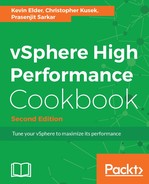A TCP message must be broken down into Ethernet frames. The size of each frame is determined by the maximum transmission unit (MTU). The default maximum transmission unit is either 1,500 bytes or 9,000 bytes for jumbo frames. The process of breaking messages into frames is called segmentation.
Modern NIC adapters have the ability to perform checksum calculations natively. TCP checksums are used to determine the validity of transmitted or received network packets based on the error-correcting code. These calculations are traditionally performed by the host's CPU. By offloading these calculations to the network adapters, the CPU is freed up to perform other tasks. As a result, the system as a whole runs better. TCP segmentation offload (TSO) allows a TCP/IP stack from the guest OS inside the VM to emit large frames (up to 64 KB) even though the MTU of the interface is smaller.
Earlier operating systems used the CPU to perform segmentation. Modern NICs try to optimize this TCP segmentation using a larger segment size as well as offloading the work from the CPU to the NIC hardware. ESXi utilizes this concept to provide a virtual NIC with TSO support, without requiring specialized network hardware.
- With TSO, instead of processing many small MTU frames during the transmission, the system can send fewer, larger virtual MTU frames.
- TSO improves the performance of the TCP network traffic coming from a VM and the network traffic sent out of the server.
- TSO is supported at the VM level and in the VMkernel TCP/IP stack.
- TSO is enabled on the VMkernel interface by default. If TSO becomes disabled for a particular VMkernel interface, the only way to enable it is to delete the VMkernel interfaces and recreate them with TSO enabled.
- TSO is used in the guest when the VMXNET 2 (or later) network adapter is installed. To enable TSO at the VM level, you must replace the existing VMXNET or flexible virtual network adapter with a VMXNET 2 (or later) adapter. This replacement might result in a change in the MAC address of the virtual network adapter.
